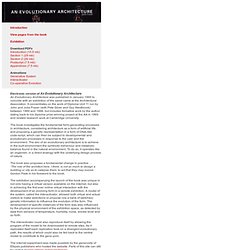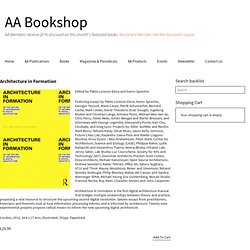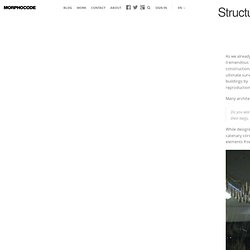

An Evolutionary Architecture - John Frazer. Exhibition The exhibition accompanying the launch of the book was unique in not only having a virtual version available on the internet, but also in achieving the first ever online virtual interaction with the development of an evolving form in a remote exhibition.

A model of the system, called the Interactivator, allowed both virtual and actual visitors to make selections or propose (via a bank of switches) genetic information to influence the evolution of the form. The development of specific instances of the form was also influenced by the physical environment of the exhibition space, as detected by data from sensors of temperature, humidity, noise, smoke level and so forth. The Interactivator could also reproduce itself by allowing the program of the model to be downloaded to remote sites.
As it replicated itself each replication took on a divergent evolutionary path, the results of which could also be fed back to the central model to contribute to the gene pool. An Evolutionary Architecture - John Frazer. Electronic version of An Evolutionary Architecture An Evolutionary Architecture was published in January 1995 to coincide with an exhibition of the same name at the Architectural Association.

It concentrates on the work of Diploma Unit 11 run by John and Julia Frazer (with Pete Silver and Guy Westbrook) between 1989 and 1996, but includes formative work by the author dating back to his diploma prize-winning project at the AA in 1969 and related research work at Cambridge University. Parametric Design for Architecture: Amazon.co.uk: Wassim Jabi. Mputational Design Modeling: Proceedings of the Design Modeling Symposium Berlin 2011: Amazon.co.uk: Christoph Gengnagel, A. Kilian, Norbert Palz, Fabian Scheurer.
Architecture in Formation. Edited by Pablo Lorenzo-Eiroa and Aaron Sprecher Featuring essays by Pablo Lorenzo-Eiroa, Aaron Sprecher, Georges Teyssot, Mario Carpo, Patrik Schumacher, Bernard Cache, Mark Linder, David Theodore, Evan Douglis, Ingeborg Rocker and Christian Lange, Antoine Picon, Michael Wen-Sen Su, Chris Perry, Alexis Meier, Achim Menges and Martin Bressani, and interviews with George Legendre, Alessandra Ponte, Karl Chu, CiroNajle, and Greg Lynn.

Architecture in Formation is the first digital architecture manual that bridges multiple relationships between theory and practice, proposing a vital resource to structure the upcoming second digital revolution. Sixteen essays from practitioners, historians and theorists look at how information processing informs and is informed by architecture. Twenty-nine experimental projects propose radical means to inform the new upcoming digital architecture. Inside Smartgeometry. Inside Smartgeometry: Expanding the Architectural Possibilities of Computational Design Edited by Brady Peters and Terri Peters On behalf of the Smartgeometry group, we would like to invite you to the launch of "Inside Smartgeometry: Expanding the Architectural Possibilities of Computational Design" edited by Brady and Terri Peters and published by John Wiley & Sons.

The richly illustrated, hard cover book features 24 original texts from members of the SG community. It provides both a history of the past ten years of SG, and offers ideas for the future of computational design in architecture. To celebrate the book´s release, join us for drinks and a few words by the Smartgeometry Directors. 21 March 2013 6.30 pm The Bartlett School of Architecture UCL, Royal Ear Hospital Ground Floor, Capper Street (corner of Huntley Street) London, WC1E 6AP Smartgeometry (SG) is a key influence on the architectural community who explore creative computational methods for the design of buildings.
Structure in Nature is a Strategy for Design: Peter Pearce: 9780262660457: Amazon.com. Structure in nature is a strategy for design. As we already wrote in previous posts, observing Natural phenomena and structures might be a tremendous source of inspiration for architects.

Nature has the talent to solve functional and constructional problems with zero net energy consumption using adaptivity to local conditions as an ultimate survival strategy. Architects can provide the same functional and energy efficiency for buildings by using similar design principles or analysing natural models … and this is not just a formal reproduction- this is a design strategy. Many architects were inspired by Nature. Gaudi once said: Do you want to know where I found my model? While designing the Sagrada Familia, in order to evolve a structure in equilibrium, Gaudi designed catenary cord models with weights that transformed the hanging curves into funicular polygonal elements from which the masons took measurements.
Photo courtesy of Suzie Many others use the same strategy: Frei Otto, Arata Izozaki, Cecil Balmond to name a few… Nice. Structure in nature is a strategy for design.